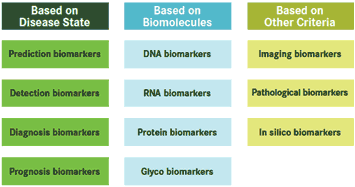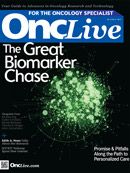Publication
Article
Oncology Live®
The Great Biomarker Chase: Promise & Pitfalls Along the Path to Personalized Care
Author(s):
Biomarkers offer great potential for improving management of cancer at every point from screening and detection, to diagnosis, staging, prognosis, and the assessment of treatment response.

Visualization of a molecular network integrated with a gene profile.
In recent years, the sequencing of the human genome and advances in supercomputer technology have helped drive hopes that a deeper understanding of the biology of cancer would yield the markers needed to truly usher in the long-awaited era of personalized medicine.
Biomarkers offer great potential for improving management of cancer at every point from screening and detection, to diagnosis, staging, prognosis, and the assessment of treatment response. Striking advances have been made in several fields, particularly breast cancer, and fresh research suggests significant steps forward in lung cancer.
Yet progress has been slow in the vast, ever-changing, and controversial frontier of biomarker research, with fewer than 2 dozen cancer biomarkers approved so far by the FDA among the thousands researchers have explored.1
Experts have advanced a brew of reasons for the gap between potential and performance, in a complex field that requires the coordination of a diverse team of pathologists, molecular biologists, and biostatisticians.
Last year, the AACR-FDA-NCI Cancer Biomarkers Collaborative described a “growing imperative” to modernize the drug development process, and made 27 recommendations in 8 different areas for doing so.2
Meanwhile, the pharmaceutical industry is exploring ways to improve biomarker development, with some industry analysts seeing regulatory issues as a significant sticking point in economically feasible biomarker development (Read More: Industry Testing New Models for Developing Biomarkers).
Sudhir Srivastava, PhD, MPH, the founding chief of the Cancer Biomarkers Research Group at the National Cancer Institute, said in an interview with OncLive that one of the challenges in biomarker research is the unrealistic expectations promoted by many study investigators.
“With almost every paper, even if there is a remote chance of success, you see a press release hyping a discovery, but later on they fail,” Srivastava said. “The public gets so excited about it that they demand we must succeed as soon as possible. But the fact of the matter is, the hype usually does not translate into clinical studies.”
At the same time, Srivastava said, the scientific community is getting organized and gaining momentum. “The infrastructure is in place to move forward in the right direction. More breakthroughs are a matter of time,” he said.
Proposal for classifying Biomarkers

Adapted from Mishra A, Mukesh V. Cancer biomarkers: are we ready for the prime time? Cancers 2010; 2:190-208; doi:10.3390/cancers2010190.
Notable Shortcomings Analyzed
Many researchers who have reviewed the progress made on biomarkers thus far have found much to criticize.
In 2010, Eleftherios P. Diamandis, MD, PhD, professor and head of the Division of Clinical Biochemistry, University of Toronto, Canada, and associate scientist at the Samuel Lunenfeld Research Institute of Mount Sinai Hospital, Toronto, reviewed cancer biomarkers initially hailed as breakthroughs and their subsequent failings.3
These included nuclear magnetic resonance of serum for cancer diagnosis; lysophosphatidic acid for ovarian cancer; 4- and 6-parameter diagnostic panels for ovarian cancer; osteopontin for ovarian cancer; early prostate cancer antigen-2 (EPCA-2) for prostate cancer detection; proteomic profiling of serum by mass spectrometry for ovarian cancer diagnosis; and peptidomic patterns for cancer diagnosis.3
Diamandis found problems ranging from inappropriate statistical analysis to biases in patient and control subject selection. Problems with EPCA- 2, for example, included reporting values that were beyond the detection limit of the assay and using inappropriate agents to test EPCA-2.
Duke University recently gained the national spotlight in one of the most widely publicized biomarker failings. A research team had devised genetic tests to assess tumor cells by looking for gene patterns that would determine which drugs would best attack a particular cancer. The tests turned out to be worthless, though they were once hailed as a breakthrough that was seen as the first fruit of the new genomics.
The Duke research was discovered to be fl awed only because it relied on publicly available data sets and algorithms. Keith A. Baggerly, PhD, and Kevin R. Coombes, PhD, statisticians at MD Anderson Cancer Center in Houston, Texas, spent 2000 hours finding all of the errors in the research and found even simple errors, such as row or column offsets.4
And at the NCI, the Cancer Biomarkers Research Group recently did its own random review of 1000 papers detailing biomarker discoveries. “In almost 90 percent of the papers, there was a lot of hype,” Srivastava said.
Biomarker Successes Stand Out
Of course, there have been successes in the cancer biomarker field, one of the more significant biomarkers being the protein HER2, which is the target of the breast-cancer drug trastuzumab (Herceptin).
First discovered in the early 1980s, HER2 can be found on some breast tissues, and an excess of this protein is found in some forms of breast cancer. Another example is the Philadelphia chromosome, a marker for chronic myeloid leukemia, which results from the movement of DNA from one site on the human genome to another.
At the American Society of Clinical Oncology (ASCO) conference in June, featured research included a prospective study by the 14-member Lung Cancer Mutation Consortium that identified at least 1 of 10 “driver” mutations in tumors of nearly two-thirds of patients with advanced lung cancer.5
In a phase I trial, researchers from MD Anderson demonstrated that the ability to match individual patients with targeted cancer therapies based on the molecular profile of their tumors resulted in dramatically superior clinical outcomes, a finding that may improve patient selection for clinical trials at early stages and thus help speed drug development.6
In addition, researchers at Indiana University Melvin and Bren Simon Cancer Center in Indianapolis discovered the first predictive biomarker for taxane-induced peripheral neuropathy, single nucleotide polymorphisms in the RWDD3 gene, through a genetic analysis of more than 2000 breast cancer patients.7
The Cancer Biomarkers Research Group, which operates the Early Detection Research Network (EDRN), a collaborative effort of nearly 40 institutions, has a goal of accelerating the translation of biomarker information into clinical applications and evaluating new ways of testing tumors for predictive markers.
“But we see our role as not just to be the accelerator of biomarker findings, but also to put the brake on bad findings,” Srivastava said of the EDRN.
Key Hurdles Identified
Srivastava highlighted 3 key hurdles that have historically held back biomarker progress: a lack of foundational studies, a lack of sustained funding, and a lack of quality biological samples for testing.
“The most important players in industry and the federal government are not investing enough, yet expectations are very high,” he said. “If you look at the funding level for early detection and diagnosis, it is not as high as one would like to see as you do in drugs.”
His budget is between $20 million and $26 million a year, spread out over about 40 institutions, which boils down to about $600,000 per institution.
“It’s not enough to do the discovery,” he said, noting that investment in biomarkers may not be as appealing to investors because it is a long-term effort, while investors want to see short-term gains.
A lack of acceptable biological samples also has been a big obstacle, Srivastava and other scientists said. Many programs do not use quality samples, or there is not much information about the stage at which samples were collected.
Dean E. Brenner, MD, of the University of Michigan Medical Center, tackled this question during an ASCO presentation titled “An Update on Biomarkers for the Early Detection of Cancer, Prediction of Prognosis, and as Surrogate Endpoints for Cancer Prevention.”
“Garbage in, garbage out,” he said, noting that biosamples can be unstable and difficult to analyze. “You need good quality.”
Martin J. van den Bent, MD, PhD, Erasmus University Medical Center, The Netherlands, in a presentation on “Molecular Biomarkers in Neuro-oncology: Ready for Clinical Practice?” at the ASCO annual meeting, stressed the need for the adequate analytical performance of biomarkers, clinical performance, and the need for independent validation.
He cautioned that the biomarker research is still in need of development: “We need to think twice before we topple the old regime…We could be looking at something so young and immature, the ugly ducklings that need to mature over time.”
What is a Biomarker?
“A characteristic that is objectively measured and evaluated as an indicator of normal biologic processes, pathogenic processes, or pharmacologic responses to a therapeutic intervention.”
—Biomarkers Definitions Working Group
“A biological molecule found in blood, other body fluids, or tissues that is a sign of a normal or abnormal process, or of a condition or disease. A biomarker may be used to see how well the body responds to a treatment for a disease or condition. Also called molecular marker and signature molecule.”
—National Cancer Institute
" An ideal biomarker provides high positive and negative predictive values, should be easy to sample, cheap to assay, provide ease of quality control, and should be convenient for algorithmic usage."
—Dean E. Brenner, MD,
University of Michigan Medical Center
Moving Forward With Hope and Caution
None of the hurdles or the comparatively slow pace of progress means it is time to give up hope, Srivastava said.
He said the most promising areas of cancer biomarker research over the next 5 years are in prostate, ovarian, and colon cancers, and scientists are focusing more and more not just on single biomarkers, but on panels of biomarkers as successful diagnostic tools.
ASCO and other professional organizations are developing guidelines to help clinicians sort data regarding the usefulness of biomarkers in treating patients. Timothy D. Gilligan, MD, an oncologist in the Solid Tumor Oncology department at the Cleveland Clinic in Ohio, was part of an ASCO panel that developed guidelines on the appropriate uses for serum markers of germ cell tumors (GCTs).8
The panel did an exhaustive search of published material, reviewing hundreds of papers to identify relevant studies, and developed consensus guidelines based on data from 81 reports.
Gilligan noted that GCTs are unique in that they are largely curable, even when they are very advanced, and that biomarkers have been used for a long time to measure tumor progression, with a fair amount of evidence supporting their use.
“In almost all cases, when the marker goes up, it is a sign of the tumors progressing, and when the marker goes down, they are responding to treatment,” he said.
“There is a lot at stake in doing it right, though, so you don’t overtreat people,” he said.
Like many other clinicians, Gilligan sees not only accuracy and reliability as a big challenge with biomarkers, but also raises the question of utility.
“Just because you can measure something doesn’t mean it is helpful to measure,” he said. “There are plenty of tumor markers that are often elevated if cancer is present, but knowing whether the marker is going up or down does not necessarily mean better care for the person.”
“If markers go up six months before a scan goes up, is it helpful to start treatment six months earlier?” he said. “In the vast majority of cases there [are] no data.”
Markers are most useful, he said, in diagnosing cancers where effective treatments exist.
In some cases like ovarian cancer, evidence suggests the earlier detection of a cancer antigen biomarker, CA125, does not help patients do better, Gilligan said. The flip side of the story, he said, is prostate-specific antigen (PSA), which is very sensitive. A rise in PSA does not necessarily impact wellness, or mean a man has prostate cancer, but Gilligan noted it often creates anxiety, with no consequences, and much time is spent reassuring patients.
“There is a potential for markers to do harm,” Gilligan said.
He added, however, that new biomarkers that are more specific could be very useful in many areas.
“If you use a test, there should be evidence that it is useful,” he said. “We are trying to rein people in so they do not order so many tests when there is no meaningful evidence.”
References
Krystal Knapp is a freelance writer living in New Jersey.
- Rhea J, Molinaro R. Cancer Biomarkers: Surviving the journey from bench to bedside. Medical Laboratory Observer, 2011; 43 (3):10-18.
- Khleif SN, Doroshow JH, Hait WN. AACR-FDA-NCI Cancer Biomarkers Collaborative consensus report: advancing the use of biomarkers in cancer drug development. Clin Cancer Res. 2010;16:3299-3318.
- Diamandis EP. Cancer biomarkers: can we turn recent failures into success? J Natl Cancer Inst. 2010;102:1462-1467.
- Baggerly K, Coombes K. Deriving chemosensitivity from cell lines: forensic bioinformatics and reproducible research in high-throughput biology. Ann. Appl. Stat., 2009; 3(4):1309-1334.
- Kris MG, Johnson BE, Kwiatkowski AJ, et al. Identifi cation of driver mutations in tumor specimens from 1000 patients with lung adenocarcinoma: the NCI’s Lung Cancer Mutation Consortium (LCMC). J Clin Oncol. 2011. (suppl; abstract CRA7506).
- Tsimberidou AM, Iskander NG, Hong DS, et al. Personalized medicine in a phase I clinical trials program: the MD Anderson Cancer Center Initiative. J Clin Oncol. 2011. (suppl; abstract CRA2500).
- Schneider BP, Li L, Miller K, et al. Genetic associations with taxane-induced neuropathy by a genome-wide association study (GWAS) in E5103. J Clin Oncol. 2011. (abstract 1000).
- Gilligan TD, Seidenfeld J, Basch EM, et al. American Society of Clinical Oncology Practice Guidelines on uses of serum tumor markers in adult males with germ cell tumors. J Clin Oncol, 2010; 28(20):3388-3404.










